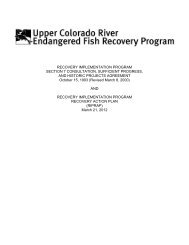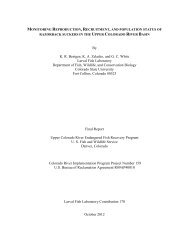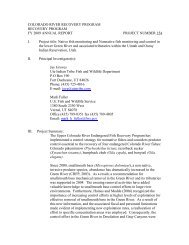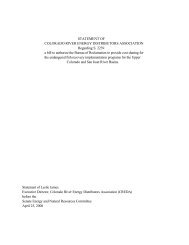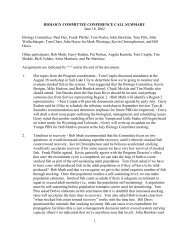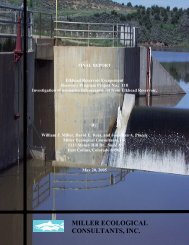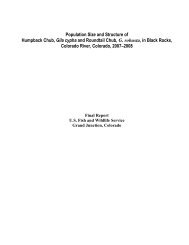Final Programmatic Biological Opinion for Bureau of Reclamation's
Final Programmatic Biological Opinion for Bureau of Reclamation's
Final Programmatic Biological Opinion for Bureau of Reclamation's
You also want an ePaper? Increase the reach of your titles
YUMPU automatically turns print PDFs into web optimized ePapers that Google loves.
Echo Park, Island Park, and Swallow Canyon (Smith 1960, Vanicek et al. 1970). Individualswere also reported from the lower Yampa River (Holden and Stalnaker 1975b), the White Riverin Utah (Sigler and Miller 1963), Desolation Canyon <strong>of</strong> the Green River (Holden and Stalnaker1970) and the Colorado River near Moab (Sigler and Miller 1963).Critical habitat was designated in 1994 within the humpback chub's historical range in thefollowing sections <strong>of</strong> the upper Colorado River (59 F.R. 13374). The primary constituentelements are the same as those described <strong>for</strong> the Colorado pikeminnow.Utah, Grand County; and Colorado, Mesa County. The Colorado River from BlackRocks in T. 10 S., R. 104 W., section 25 (6th Principal Meridian) to Fish Ford in T. 21 S.,R. 24 E., section 35 (Salt Lake Meridian).Utah, Garfield and San Juan Counties. The Colorado River from Brown Betty Rapid in T.30 S., R. 18 E., section 34 (Salt Lake Meridian) to Imperial Canyon in T. 31 S., R. 17 E.,section 28 (Salt Lake Meridian).Status and DistributionToday the largest populations <strong>of</strong> this species occur in the Little Colorado and Colorado Rivers inthe Grand Canyon, and in Black Rocks and Westwater Canyon in the upper Colorado River.Other populations have been reported in De Beque Canyon <strong>of</strong> the Colorado River, Desolation andGray Canyons <strong>of</strong> the Green River, Yampa and Whirlpool Canyons in Dinosaur NationalMonument (USFWS 1990b). One individual was recently captured in the Gunnison River(Burdick 1995).In general, the existing habitat has been modified to the extent that it impairs essential behaviorpatterns, such as breeding, feeding, and sheltering.Life HistoryIt is known that these chubs spawn soon after the highest spring flows when water temperaturesapproach 68° F (Kaeding et al. 1990; Karp and Tyus 1990; USFWS 1990b). The collection <strong>of</strong>ripe and spent fish indicated that spawning occurred in Black Rocks during June 2-15, 1980, atwater temperatures <strong>of</strong> 11.5° to 16° C; in 1981, spawning occurred May 15-25, at watertemperatures <strong>of</strong> 16° to 16.3° C (Valdez et al. 1982). Humpback chub spawned in Black Rocks onthe Colorado River in 1983 when maximum daily water temperatures were 12.6° to 17° C(Archer et al. 1985). In the Grand Canyon, humpback chub spawn in the spring between Marchand May in the Little Colorado River when water temperatures are between 16° and 22° C.Swimming abilities <strong>of</strong> young-<strong>of</strong>-year humpback chub were determined to be significantly reducedwhen laboratory water temperatures were reduced from 20° to 14° C. Many young-<strong>of</strong>-yearhumpback chub are displaced from the Little Colorado River into the mainstem by monsoonalfloods from July through September (Valdez and Ryel 1995). Young humpback chub are found33



